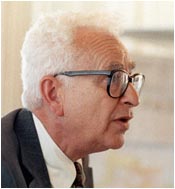

Murray Gell-Mann
1964 Symmetry operations on an octahedron illustrate the theory of quarks. By the 1960s, accelerators had revealed dozens of new particles. Theorist Murray Gell-Mann (and, independently, Yuval Ne'eman) discovered a theory that organized all the particles into families with properties mathematically the same as those of a "group of eight" in abstract algebra. Gell-Mann called it "The Eightfold Way." When physicists recognized that underlying fundamental particles could explain the eightfold pattern, the idea of quarks was born. In the 1970s, experiments at the Department of Energy's SLAC showed that quarks were not just mathematical constructs but real building blocks of protons and neutrons.